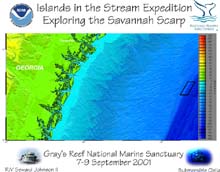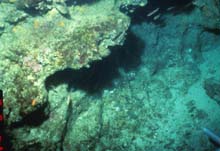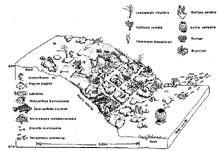
Poster showing the bathymetry of the coast off Georgia and the location of Savannah Scarp expedition. Click image for larger view.
A Profile of Savannah Scarp
George R. Sedberry
Senior Marine Scientist
Marine Resources Research Institute
South Carolina Department of Natural Resource
Description
The continental shelf of the South Atlantic Bight (Cape Hatteras, NC to Cape Canaveral, FL) consists of a sandy flat bottom that gradually slopes from the beach to the edge of the continental shelf. The smooth shelf is occasionally interspersed with rocky outcrops, such as those in the Gray’s Reef National Marine Sanctuary (GRNMS), which are attractive to reef fishes such as snappers and groupers. Moving offshore from the beach, the first "shelf break" consists of a series of rocky ridges and outcrops, where Gulf Stream currents have diverted sediments away from the underlying rock. This shelf-edge reef occurs at about 55 m depth (180 ft), and the bottom drops steeply to 70 m (250 ft) or more. Along this edge is a spectacular ribbon of reef habitat, consisting of large rocks, ridges, ledges, caves and overhangs that provide habitat for an abundant and diverse fauna. Many fishes of economic importance, such as snappers, groupers, grunts and porgies, inhabit these reefs. The ribbon of reef is discontinuous along the edge of the continental shelf. Off the coast of Savannah, Georgia, however, the shelf-edge reef is very well developed into a series of two or more parallel ridges in depths from 55 m (180 ft) to 90 m (295 ft). On published fishing charts of the region, these deep reefs are known as "The Deli" and "The Sow Pen." Although it is known to be an important fish habitat, the full extent of reef habitat at the Savannah Scarp, and the portions of the habitat used by particular fish species, is unknown.

Outcrops along the Savannah Scarp provide shelter for an abundance of fish and invertebrates. Click image for larger view.
Mission Objectives
The Savannah Scarp Mission of the Islands in the Stream Expedition is being conducted in conjunction with fisheries research and monitoring at Gray’s Reef, a well-developed hard- bottom reef on the inner continental shelf southwest of Savannah Scarp. Research at Savannah Scarp will focus on a description of habitats and fishes at this shelf-edge reef, which is located downstream of the Gray's Reef National Marine Sanctuary. Scientists will compare fish populations observed from the submersible at Savannah Scarp to populations observed via scuba at the sanctuary. They will investigate the role of shelf-edge reefs as sources and destinations of recruits of reef fishes that inhabit marine protected areas (MPAs), such as the Oculina Experimental Research Reserve and the Gray's Reef Sanctuary. They will examine species composition as well as the distribution of fish eggs and larvae in relation to prevailing currents. Samples of microscopic benthic and planktonic animals will serve as indicators of oceanographic conditions. DNA samples from representative organisms will clarify relationships between populations of organisms at the Savannah Scarp and those in upstream protected areas.
Daily logs and photographs will be posted on the Ocean Explorer Web site.

These specially designed traps isolate the shrimps and crabs inside from light and elevated water temperatures as they are brought to the surface. Click image for larger view.
Habitats
This mission will focus on rocky reef habitats, examining habitat preferences of fishes and abundance among habitats. It will also examine fish distribution in relation to bottom features and associated large invertebrates, such as sponges and corals. Habitats to be examined include:
- rocky ledges
- soft sediment
- bank reefs
- deep rocky reefs
- drowned reefs
- temperate reefs
- pinnacles
- hard bottom.
Key Species
Economically important species found at shelf-edge reefs include snappers, groupers, grunts, porgies, tilefishes and filefishes. The habitat is also home to many species of small, colorful fishes, such as damselfish, butterflyfish, angelfish and wrass. Scientists from the South Carolina Department of Natural Resources have documented more than 300 species of fish at these depths. Because of the diversity of habitats (e.g. sand, hard flats, rocky ridges), and the proximity of tropical and temperate water masses, a variety of tropical, subtropical and temperate species exist at these shelf-edge reefs. Dominant species are listed in the following table.
Grunts
Tomtate* Haemulon aurolineatum Snappers
Vermilion snapper* Rhomboplites aurorubens Red snapper* Lutjanus campechanus Groupers and Sea Basses
Black sea bass* Centropristis striata Bank sea bass Centropristis ocyurus Tattler Serranus phoebe Saddle bass Serranus notospilus Scamp* Mycteroperca phenax Sand perch Diplectrum formosum Pelagic forage fishes
Round scad Decapterus punctatus Round herring Etrumeus teres Porgies
Red porgy* Pagrus pagrus Scup Stenotomus chrysops Knobbed porgy* Calamus nodosus Triggerfishes
Gray triggerfish* Balistes capriscus Planehead filefish Monacanthus hispidus Jacks
Greater amberjack* Seriola dumerili Small tropical reef fishes
Yellowtail reeffish Chromis enchrysura Spotfin hogfish Bodianus pulchellus Bank butterflyfish Chaetodon aya Spotfin butterflyfish Chaetodon ocellatus Reef butterflyfish Chaetodon sedentarius Blue angelfish Holacanthus bermudensis Slippery dick Halichoeres bivittatus Squirrelfish Holocentrus ascensionis Bigeye Priacanthus arenatus Cubbyu Equetus umbrosus Other demersal fishes
Offshore lizardfish Synodus poeyi * Economically important species
Protected Areas
The Savannah Scarp reefs are not within a protected area. They are, however, downstream from the Oculina Research Reserve and the Gray’s Reef National Marine Sanctuary. The Savannah Scarp may be an area of recruitment for fish that spawn in upstream protected areas. Shelf-edge reefs are important spawning areas for gag, red grouper, gray triggerfish and other species, and may be appropriate candidate sites for additional protective management.
Interesting Facts
- The Savannah Scarp is a popular recreational fishing ground.
- Red snapper and knobbed porgy spawn there.
- Shelf-edge reefs such as the Savannah Scarp are areas where the warm Gulf Stream overlays rocky bottom. This creates a reef habitat suitable for tropical and subtropical species, and many fishes found at the Savannah Scarp are also found in islands of reef habitat far upstream in the Caribbean. This includes many species of butterflyfish, angelfish and wrass.
- The diversity of bottom types (e.g., sand, rocky flats, rock ridges) and the confluence of oceanic Gulf Stream and shelf waters result in very high fish diversity.
- Although shelf-edge reefs such as Savannah Scarp are productive fishing grounds, the habitat is very limited and discontinuous. Thus, population sizes are also limited, making them subject to overfishing.
- The rock outcroppings at Savannah Scarp are composed of oolitic sands that were cemented during previous low sea-level stands. Some of the larger limestone outcroppings were probably formed as the result of eroded ancient aquifers. The rock outcroppings are most likely Eocene or Oligocene formations.
Sign up for the Ocean Explorer E-mail Update List.











































